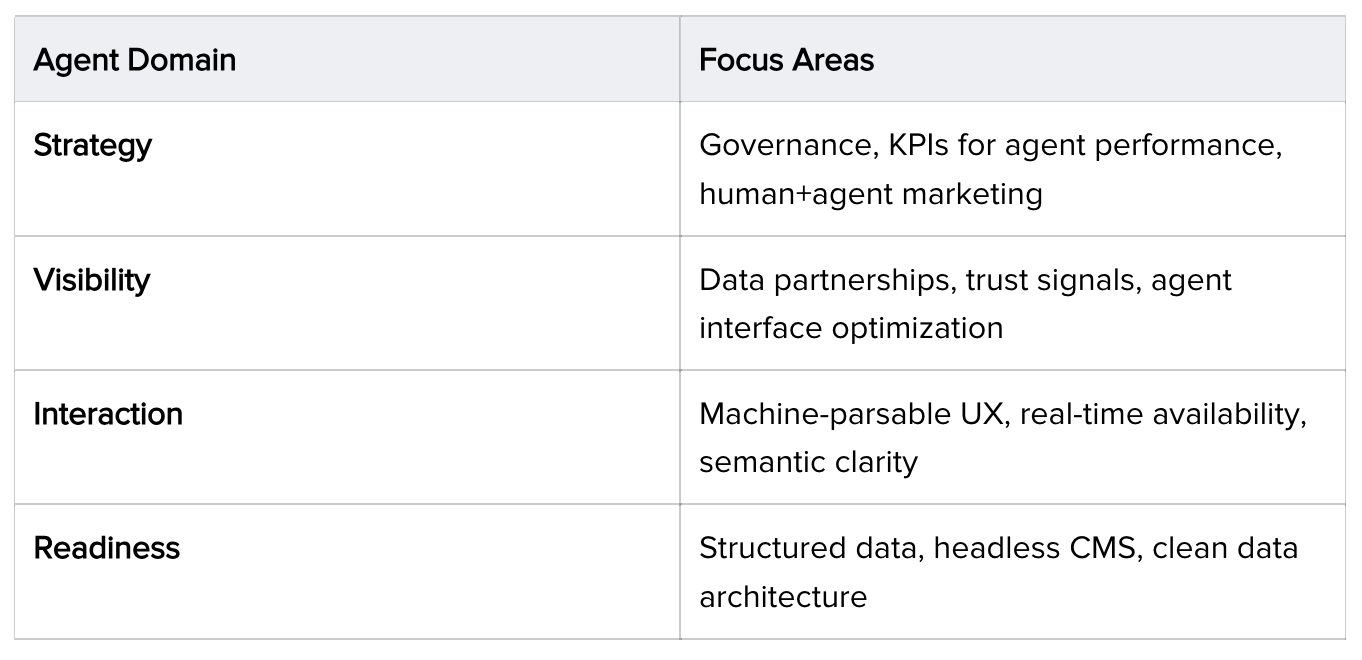The implications are vast. While agentic browsing clearly affects marketing and user experience, it also reshapes strategic planning, data architecture, competitive positioning, and the fundamentals of customer relationships.
Here are the 10 key dynamics reshaping the business landscape that leaders need to know.
In traditional browsing, a user discovers your website, engages with your brand, and (if all goes well) converts. That journey is tactile and emotional, filled with storytelling, visual branding, and experiential design.
But, in agentic browsing, the user never sees your website. Their AI assistant reads it, extracts relevant data, compares it to competitors, and delivers a recommendation. That means:
-
Visual design becomes less relevant.
-
Emotional storytelling is deprioritized.
-
Structured, machine-readable content becomes paramount.
In this new era, your “digital front door” is your data layer, not your homepage.
Agentic browsers flatten the traditional customer journey. Awareness, interest, and consideration are compressed into a single query. A user may ask, “Find me the best executive coach in Chicago,” and the agent delivers a shortlist based on structured data, trust signals, and semantic clarity. If you're not on that shortlist, you're invisible.
The consequence of agentic browsing is you must now win before the prospect even knows you exist. Optimizing for agent inclusion becomes as critical as traditional marketing tactics.
In the age of AI intermediaries, many agents won’t visit your site at all. They’ll pull structured content, metadata, and third-party signals directly from SERPs, APIs, or third-party aggregators. The implication is that leaders must re-evaluate what digital success looks like, as:
-
Traffic no longer indicates interest.
-
Bounce rate, session time, and heatmaps will provide diminishing strategic insight.
-
“Zero-click engagement” will become the norm.
If agents are now your customers, your brand must be both discoverable and understandable to them. To stay competitive, businesses must fuse marketing and data efforts around one goal: making digital hygiene a core strength. Start by:
-
Implementing schema markup and JSON-LD.
-
Maintaining a clean, agent-accessible CMS.
-
Structuring pricing, reviews, and offerings for machine parsing.
In SEO, the goal was to rank high in search results. In agentic browsing, the game changes. The metric of the future is “share of response.” In other words, how frequently your brand appears in an agent’s curated answers. Strategic positioning now means asking: Are we giving AI enough reason to choose us? To excel, focus on:
-
Structured trust signals (citations, reviews, third-party data).
-
Clarity of positioning.
-
Alignment with user intent (as interpreted by the agent).
AI agents are ruthlessly efficient. They compare features, prices, and reviews in milliseconds. Emotional branding can be stripped away, leaving only the raw data. In today’s age, unless your brand has proprietary value, customer lock-in (e.g., subscription or community), or data advantages, you risk becoming another line in a comparison table.
Moving forward, leaders must focus on defensibility. What can you offer that’s hard to replicate or quantify?
Your future customer may never interact with your sales team, view your website, or click an ad. Instead, their agent will:
-
Shortlist vendors
-
Draft RFPs
-
Auto-fill applications
-
Negotiate contracts (soon)
B2B sales, once relationship-driven, are becoming agent-intermediated. That requires new playbooks:
-
Make RFP content agent-readable
-
Publish structured case studies and outcome-based data
-
Build trust signals that agents can scrape and synthesize
To navigate this shift, leaders must own the transformation. That means:
-
Assigning accountability for agent-facing content
-
Auditing all digital properties for machine-readability
-
Educating boards and stakeholders on AI-mediated brand visibility
-
Measuring “agent performance” alongside human UX
This evolution changes business processes and human behavior. Consumers are delegating more than ever by leveraging AI to research, book, compare, and purchase. While more efficient, this introduces a new layer of psychological distance between brand and buyer. Your ability to influence may no longer rest on a clever ad or emotional appeal—it will depend on how well an algorithm understands your offering.
To prepare, CEOs should evaluate readiness across four domains:

As AI agents grow in capability, they will become gatekeepers, curators, and eventually decision-makers. Businesses that fail to adapt will find themselves invisible. Those that embrace the shift will earn a privileged position in the customer’s most trusted interface.
Copyright © 2025 by The AI Whisperer LLC. All rights reserved.

